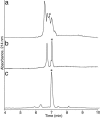Engineering stable peptide toxins by means of backbone cyclization: stabilization of the alpha-conotoxin MII
- PMID: 16162671
- PMCID: PMC1236553
- DOI: 10.1073/pnas.0504613102
Engineering stable peptide toxins by means of backbone cyclization: stabilization of the alpha-conotoxin MII
Abstract
Conotoxins (CTXs), with their exquisite specificity and potency, have recently created much excitement as drug leads. However, like most peptides, their beneficial activities may potentially be undermined by susceptibility to proteolysis in vivo. By cyclizing the alpha-CTX MII by using a range of linkers, we have engineered peptides that preserve their full activity but have greatly improved resistance to proteolytic degradation. The cyclic MII analogue containing a seven-residue linker joining the N and C termini was as active and selective as the native peptide for native and recombinant neuronal nicotinic acetylcholine receptor subtypes present in bovine chromaffin cells and expressed in Xenopus oocytes, respectively. Furthermore, its resistance to proteolysis against a specific protease and in human plasma was significantly improved. More generally, to our knowledge, this report is the first on the cyclization of disulfide-rich toxins. Cyclization strategies represent an approach for stabilizing bioactive peptides while keeping their full potencies and should boost applications of peptide-based drugs in human medicine.
Figures






References
-
- Adams, D. J., Alewood, P. F., Craik, D. J., Drinkwater, R. D. & Lewis, R. J. (1999) Drug Dev. Res. 46, 219–234.
-
- Terlau, H. & Olivera, B. M. (2004) Physiol. Rev. 84, 41–68. - PubMed
-
- Miljanich, G. P. (2004) Curr. Med. Chem. 11, 3029–3040. - PubMed
-
- Livett, B. G., Gayler, K. R. & Khalil, Z. (2004) Curr. Med. Chem. 11, 1715–1723. - PubMed
-
- Dutton, J. L. & Craik, D. J. (2001) Curr. Med. Chem. 8, 327–344. - PubMed
Publication types
MeSH terms
Substances
Associated data
- Actions
- Actions
LinkOut - more resources
Full Text Sources
Other Literature Sources

